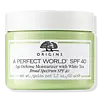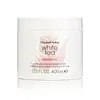What's inside
What's inside
 Key Ingredients
Key Ingredients

 Benefits
Benefits

 Concerns
Concerns

 Ingredients Side-by-side
Ingredients Side-by-side

Butyl Methoxydibenzoylmethane 3%
UV AbsorberHomosalate 8%
Skin ConditioningEthylhexyl Methoxycinnamate 7.5%
UV AbsorberEthylhexyl Salicylate 4.5%
UV AbsorberOctocrylene 5%
UV AbsorberWater
Skin ConditioningButylene Glycol
HumectantGlycerin
HumectantAmmonium Acryloyldimethyltaurate/Vp Copolymer
Polyethylene
AbrasiveCitrus Aurantium Bergamia Fruit Oil
MaskingCitrus Limon Peel Oil
MaskingCitrus Aurantium Dulcis Oil
MaskingCinnamomum Camphora Bark Oil
MaskingMentha Viridis Leaf Oil
AstringentMagnolia Acuminata Flower Extract
Skin ConditioningIris Pallida Root Extract
MaskingRosa Damascena Extract
MaskingCitral
PerfumingLinalool
PerfumingLimonene
PerfumingCetyl Alcohol
EmollientGlyceryl Stearate
EmollientPEG-100 Stearate
PEG-6
HumectantVaccinium Angustifolium Fruit Extract
Skin ProtectingVaccinium Macrocarpon Fruit Extract
AstringentSolanum Tuberosum Pulp Extract
SmoothingLycium Chinense Fruit Extract
AntioxidantEriobotrya Japonica Leaf Extract
Skin ConditioningPassiflora Incarnata Flower Extract
Skin ConditioningLeontopodium Alpinum Extract
Skin ConditioningBetula Alba Bark Extract
MaskingCamellia Sinensis Leaf Extract
AntimicrobialBoswellia Serrata Extract
Skin ConditioningSigesbeckia Orientalis Extract
Skin ConditioningThermus Thermophillus Ferment
Skin ConditioningHordeum Vulgare Extract
EmollientTriticum Vulgare Germ Extract
Skin ConditioningSaccharomyces Lysate Extract
HumectantLythrum Salicaria Extract
AstringentYeast Extract
Skin ConditioningAlgae Extract
EmollientOryzanol
Skin ConditioningSqualane
EmollientEthylhexylglycerin
Skin ConditioningTrehalose
HumectantSteareth-21
CleansingErgothioneine
AntioxidantSodium Hyaluronate
HumectantVp/Eicosene Copolymer
Nylon-12
Caprylyl Glycol
EmollientSodium PCA
HumectantSodium Dehydroacetate
PreservativeTocopheryl Acetate
AntioxidantUrea
BufferingAscorbyl Tocopheryl Maleate
AntioxidantCitric Acid
BufferingPolyquaternium-51
Skin ConditioningHexylene Glycol
EmulsifyingLecithin
EmollientSodium Phytate
BHT
AntioxidantMica
Cosmetic ColorantPhenoxyethanol
PreservativeButyl Methoxydibenzoylmethane 3%, Homosalate 8%, Ethylhexyl Methoxycinnamate 7.5%, Ethylhexyl Salicylate 4.5%, Octocrylene 5%, Water, Butylene Glycol, Glycerin, Ammonium Acryloyldimethyltaurate/Vp Copolymer, Polyethylene, Citrus Aurantium Bergamia Fruit Oil, Citrus Limon Peel Oil, Citrus Aurantium Dulcis Oil, Cinnamomum Camphora Bark Oil, Mentha Viridis Leaf Oil, Magnolia Acuminata Flower Extract, Iris Pallida Root Extract, Rosa Damascena Extract, Citral, Linalool, Limonene, Cetyl Alcohol, Glyceryl Stearate, PEG-100 Stearate, PEG-6, Vaccinium Angustifolium Fruit Extract, Vaccinium Macrocarpon Fruit Extract, Solanum Tuberosum Pulp Extract, Lycium Chinense Fruit Extract, Eriobotrya Japonica Leaf Extract, Passiflora Incarnata Flower Extract, Leontopodium Alpinum Extract, Betula Alba Bark Extract, Camellia Sinensis Leaf Extract, Boswellia Serrata Extract, Sigesbeckia Orientalis Extract, Thermus Thermophillus Ferment, Hordeum Vulgare Extract, Triticum Vulgare Germ Extract, Saccharomyces Lysate Extract, Lythrum Salicaria Extract, Yeast Extract, Algae Extract, Oryzanol, Squalane, Ethylhexylglycerin, Trehalose, Steareth-21, Ergothioneine, Sodium Hyaluronate, Vp/Eicosene Copolymer, Nylon-12, Caprylyl Glycol, Sodium PCA, Sodium Dehydroacetate, Tocopheryl Acetate, Urea, Ascorbyl Tocopheryl Maleate, Citric Acid, Polyquaternium-51, Hexylene Glycol, Lecithin, Sodium Phytate, BHT, Mica, Phenoxyethanol
Water
Skin ConditioningParaffinum Liquidum
EmollientCetearyl Alcohol
EmollientParfum
MaskingGlycerin
HumectantCaprylic/Capric Triglyceride
MaskingGlyceryl Stearate
EmollientCetyl Acetate
EmollientCeteareth-20
CleansingTheobroma Cacao Seed Butter
EmollientDimethicone
EmollientC12-15 Alkyl Benzoate
AntimicrobialAcetylated Lanolin Alcohol
EmollientAchillea Millefolium Extract
CleansingAesculus Hippocastanum Seed Extract
Skin ConditioningAlthaea Officinalis Root Extract
Skin ConditioningButylene Glycol
HumectantButyrospermum Parkii Butter
Skin ConditioningCamellia Sinensis Leaf Extract
AntimicrobialCaprylyl Glycol
EmollientCarbomer
Emulsion StabilisingChamomilla Recutita Flower Extract
MaskingChondrus Crispus Extract
Skin ConditioningEquisetum Arvense Extract
AstringentFoeniculum Vulgare Seed Extract
Skin ConditioningHamamelis Virginiana Leaf Extract
Skin ConditioningHedera Helix Extract
AntimicrobialHumulus Lupulus Extract
AntimicrobialLavandula Angustifolia Flower Extract
CleansingPropylene Glycol
HumectantRosmarinus Officinalis Leaf Extract
AntimicrobialSalvia Officinalis Leaf Extract
CleansingSambucus Nigra Flower Extract
RefreshingTaraxacum Officinale Leaf Extract
Skin ConditioningTetrasodium EDTA
Thymus Vulgaris Leaf Extract
Skin ProtectingTriceteareth-4 Phosphate
EmulsifyingTromethamine
BufferingTussilago Farfara Leaf Extract
AstringentCitral
PerfumingCitronellol
PerfumingCoumarin
PerfumingFarnesol
PerfumingGeraniol
PerfumingHexyl Cinnamal
PerfumingHydroxycitronellal
PerfumingLimonene
PerfumingLinalool
PerfumingPhenoxyethanol
PreservativeSodium Benzoate
MaskingWater, Paraffinum Liquidum, Cetearyl Alcohol, Parfum, Glycerin, Caprylic/Capric Triglyceride, Glyceryl Stearate, Cetyl Acetate, Ceteareth-20, Theobroma Cacao Seed Butter, Dimethicone, C12-15 Alkyl Benzoate, Acetylated Lanolin Alcohol, Achillea Millefolium Extract, Aesculus Hippocastanum Seed Extract, Althaea Officinalis Root Extract, Butylene Glycol, Butyrospermum Parkii Butter, Camellia Sinensis Leaf Extract, Caprylyl Glycol, Carbomer, Chamomilla Recutita Flower Extract, Chondrus Crispus Extract, Equisetum Arvense Extract, Foeniculum Vulgare Seed Extract, Hamamelis Virginiana Leaf Extract, Hedera Helix Extract, Humulus Lupulus Extract, Lavandula Angustifolia Flower Extract, Propylene Glycol, Rosmarinus Officinalis Leaf Extract, Salvia Officinalis Leaf Extract, Sambucus Nigra Flower Extract, Taraxacum Officinale Leaf Extract, Tetrasodium EDTA, Thymus Vulgaris Leaf Extract, Triceteareth-4 Phosphate, Tromethamine, Tussilago Farfara Leaf Extract, Citral, Citronellol, Coumarin, Farnesol, Geraniol, Hexyl Cinnamal, Hydroxycitronellal, Limonene, Linalool, Phenoxyethanol, Sodium Benzoate
 Reviews
Reviews

Ingredients Explained
These ingredients are found in both products.
Ingredients higher up in an ingredient list are typically present in a larger amount.
Butylene Glycol (or BG) is used within cosmetic products for a few different reasons:
Overall, Butylene Glycol is a safe and well-rounded ingredient that works well with other ingredients.
Though this ingredient works well with most skin types, some people with sensitive skin may experience a reaction such as allergic rashes, closed comedones, or itchiness.
Learn more about Butylene GlycolCamellia Sinensis Leaf Extract is derived from the leaves of the tea plant. Black tea, green tea, and oolong tea are all harvested from this plant.
This ingredient has many skin benefits:
This ingredient contains polyphenols, a strong antioxidant. Antioxidants help fight off molecules that damage skin cells.
On top of that, the antioxidants in green tea neutralize free-radicals from the sun. This gives the skin some extra UV protection, but should not replace sunscreen.
Many components of tea have anti-inflammatory properties.
Polyphenols and L-theanine help soothe the skin and reduce irritation. The caffeine in Camellia Sinensis Leaf Extract helps calm inflamed blood vessels.
Other compounds found in tea include: Vitamin Bs, linoleic acid, magnesium, calcium, iron, and zinc.
Research has shown both drinking Camellia Sinensis Leaf Tea and applying it to the skin can help boost skin elasticity and hydration. Studies also show using tea extract may reduce sebum, or oil, production.
Learn more about Camellia Sinensis Leaf ExtractCaprylyl Glycol is a humectant and emollient, meaning it attracts and preserves moisture.
It is a common ingredient in many products, especially those designed to hydrate skin. The primary benefits are retaining moisture, skin softening, and promoting a healthy skin barrier.
Though Caprylyl Glycol is an alcohol derived from fatty acids, it is not the kind that can dry out skin.
This ingredient is also used as a preservative to extend the life of products. It has slight antimicrobial properties.
Learn more about Caprylyl GlycolCitral is a fragrance and used to add a lemon-like scent to products. It is both naturally found in plants and created synthetically. In plants, it is commonly occurring in lemon myrtle, lemongrass, lemon tea-tree, lemon verbena, and other citruses.
The EU mandates Citral be listed separately as a fragrance. It is a known allergen and may cause contact dermatitis. Citral can also used as a masking ingredient.
The term 'fragrance' is not regulated in many countries. In many cases, it is up to the brand to define this term. For instance, many brands choose to label themselves as "fragrance-free" because they are not using synthetic fragrances. However, their products may still contain ingredients such as essential oils that are considered a fragrance.
The term 'citral' is a collective term for two geometric isomers: geranial/Citral A and neral/Citral B.
Learn more about CitralGlycerin is already naturally found in your skin. It helps moisturize and protect your skin.
A study from 2016 found glycerin to be more effective as a humectant than AHAs and hyaluronic acid.
As a humectant, it helps the skin stay hydrated by pulling moisture to your skin. The low molecular weight of glycerin allows it to pull moisture into the deeper layers of your skin.
Hydrated skin improves your skin barrier; Your skin barrier helps protect against irritants and bacteria.
Glycerin has also been found to have antimicrobial and antiviral properties. Due to these properties, glycerin is often used in wound and burn treatments.
In cosmetics, glycerin is usually derived from plants such as soybean or palm. However, it can also be sourced from animals, such as tallow or animal fat.
This ingredient is organic, colorless, odorless, and non-toxic.
Glycerin is the name for this ingredient in American English. British English uses Glycerol/Glycerine.
Learn more about GlycerinGlyceryl Stearate is a mix of glycerin and stearic acid.
It is used to stabilize the mixing of water and oil ingredients. By preventing these ingredients from separating, it can help elongate shelf life. It can also help thicken the product's texture.
As an emollient, it helps soften skin and supports barrier-replenishing ingredients.
In cosmetics, Glyceryl Stearate is often made from vegetable oils or synthetically produced.
This ingredient may not be fungal-acne safe
Fun fact: The human body also creates Glyceryl Stearate naturally.
Learn more about Glyceryl StearateLimonene is a fragrance that adds scent and taste to a formulation.
It's found in the peel oil of citrus fruits and other plants such as lavender and eucalyptus. The scent of limonene is generally described as "sweet citrus".
Limonene acts as an antioxidant, meaning it helps neutralize free radicals.
When exposed to air, oxidized limonene may sensitize the skin. Because of this, limonene is often avoided by people with sensitive skin.
The term 'fragrance' is not regulated in many countries. In many cases, it is up to the brand to define this term. For instance, many brands choose to label themselves as "fragrance-free" because they are not using synthetic fragrances. However, their products may still contain ingredients such as essential oils that are considered a fragrance.
Learn more about LimoneneLinalool is a fragrance and helps add scent to products. It's derived from common plants such as cinnamon, mint, citrus, and lavender.
Like Limonene, this ingredient oxidizes when exposed to air. Oxidized linalool can cause allergies and skin sensitivity.
This ingredient has a scent that is floral, spicy tropical, and citrus-like.
Learn more about LinaloolPhenoxyethanol is a preservative that has germicide, antimicrobial, and aromatic properties. Studies show that phenoxyethanol can prevent microbial growth. By itself, it has a scent that is similar to that of a rose.
It's often used in formulations along with Caprylyl Glycol to preserve the shelf life of products.
Water. It's the most common cosmetic ingredient of all. You'll usually see it at the top of ingredient lists, meaning that it makes up the largest part of the product.
So why is it so popular? Water most often acts as a solvent - this means that it helps dissolve other ingredients into the formulation.
You'll also recognize water as that liquid we all need to stay alive. If you see this, drink a glass of water. Stay hydrated!
Learn more about Water